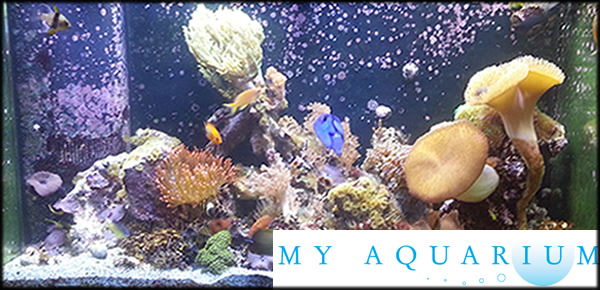Angelfish (Pomacanthidae)
Angelfish Family Characteristics:
Angelfish and Butterflyfish have many close similarities, the best way to distinguish between the two groups of fish is to look for the spine found on the gill cover of the Angelfish variety. Generally, Angelfish also have thicker bodies and a less oval shape.
The Angelfish are a very attractive group of fish that vary widely in both size and color. Some species can grow up to 24 inches in the wild, whereas the dwarf species are unlikely to grow larger than 4 inches.
As juveniles many Angelfish have a different color patterns as compared to the adults. It is not always possible to identify these juveniles with certainty; many are very similar at this stage. The juvenile Angelfish often act as 'cleaner fish' to other larger fish in the wild, many believe the juvenile markings not only advertise this fact, but also distract the aggression that could be directed at them by older and fully colored fish of the same species.
Sexual differences are barely distinguishable, although during the spawning season, females may be observed to be noticeably swollen with eggs. Spawning always occurs at dusk as a response to falling light levels. Angelfish ascend the water column and release eggs and sperm simultaneously. The fertilized eggs then float, hatch and develop in the planktonic layers for about one month. Although extremely difficult, several species of angelfish have been spawned and reared successfully to adulthood in the aquarium.
Diet And Feeding:
Most angelfish are omnivorous, feeding on a wide variety of smaller animals, algae, sponges and corals. Although members of the dwarf species rarely damage corals and sponges, the same cannot be said of large Angelfish. The larger Angelfish diet may consist entirely of sponges and corals and are not reef safe. Adults of these species may be very reluctant to accept the normal foods available to the marine aquarist during the initial settling in period.
Angelfishes should be offered a variety of foods, including live and frozen brine shrimp and Mysis, frozen squid, mussels, prawns, sponge based foods, as well as some algae.
Aquarium Behavior:
Only a few Angelfish species can be recommended to the beginner, most require at least some previous feeding and water management skills. Many species are particularly sensitive to deteriorating water conditions and quickly display their poor health by contracting various diseases, as well as losing interest in food.
The highly territorial nature of Angelfish means that mixing fish of the same, or similar, species within the confines of an average sized aquarium is usually out of the question. The more difficult species should ideally be purchased as juveniles, as they seem to adapt much better to aquarium conditions.
Suitable rockwork should be provided in which the fish can shelter at night and retreat into when disturbed. A comprehensive rockwork arrangement is essential for dwarf species, as this is where they spend much of their time. Make sure that larger species have plenty of swimming space as well.
List Of Popular Aquarium Angelfish:
- Three Spot Angelfish, Flagfin Angelfish (Apolemichthys trimaculatus)
- Purple Moon Angel (Arusetta asfur)
- African Pygmy Angelfish, Fireball Angelfish (Centropyge acanthops)
- Pygmy Angelfish, Cherubfish, Purple Fireball (Centropyge argi)
- Bicolor Cherub, Oriole Angel (Centropyge bicolor)
- Coral Beauty (Centropyge bispinosus)
- Eibl's Angelfish, Red Stripe Angelfish (Centropyge eibli)
- Lemonpeel Angelfish (Centropyge flavissimus)
- Herald's Angelfish, Yellow Angelfish (Centropyge heraldi)
- Flame Angelfish (Centropyge loriculus)
- Potters Angel (Centropyge potteri)
- Resplendent Angel (Centropyge resplendens)
- Pearl Scaled Angelfish, Half Black Angelfish (Centropyge vroliki)
- Conspicuous Angelfish (Chaetodontoplus conspicillatus)
- Scribbled Angelfish (Chaetodontoplus duboulayi)
- Blue Striped Angelfish, Blueline Angelfish (Chaetodontoplus septentrionalis)
- Blue Girdled Angelfish, Majestic Angelfish (Euxiphipops navarchus)
- Blue Faced Angelfish, Blue Masked Angelfish (Euxiphipops xanthometapon)
- Blue Angelfish (Holacanthus hermudensis)
- Queen Angelfish (Holacanthus ciliaris)
- King Angelfish (Holacanthus passer)
- Rock Beauty (Holacanthus tricolor)
- Blue Ring Angelfish, Annularis Angelfish (Pomacanthus annularis)
- Emperor Angelfish (Pomacanthus imperator)
- French Angelfish (Pomacanthus paru)
- Koran Angelfish (Pomacanthus semicirulatus)
- Regal Angelfish, Royal Empress Angelfish (Pygoplites diacanthus)
- Rusty Angelfish (Centropyge ferrugata)
- Multicolor Angelfish (Centropyge multicolor)
- Black Nox Angelfish (Centropyge nox)
- Tibicen Angelfish (Centropyge tibicin)
- Fisher's Angelfish (Centropyge fisheri)
- Pygmy Yellowtail Angelfish (Centropyge flavicauda)
- Golden Angelfish (Centropyge aurantia)
- Multibar Angelfish (Paracentropyge multifasciata)
- Goldflake Angelfish (Apolemichthys xanthopunctatus)
- Bluespotted Angelfish (Chaetodontoplus caeruleopunctatus)
- False Personifer Angelfish (Chaetodontoplus meredithi)
- Bellus Angelfish (Genicanthus bellus)
- Lamarck's Angelfish (Genicanthus lamarck)
- Spotbreast Angelfish (Genicanthus melanospilos)
- Six Bar Angelfish (Pomacanthus sexstriatus)
- Cortez Angelfish (Pomacanthus zonipectus)
- Chrysurus Angelfish (Pomacanthus chrysurus)
- Watanabei Angelfish (Genicanthus watanabei)


